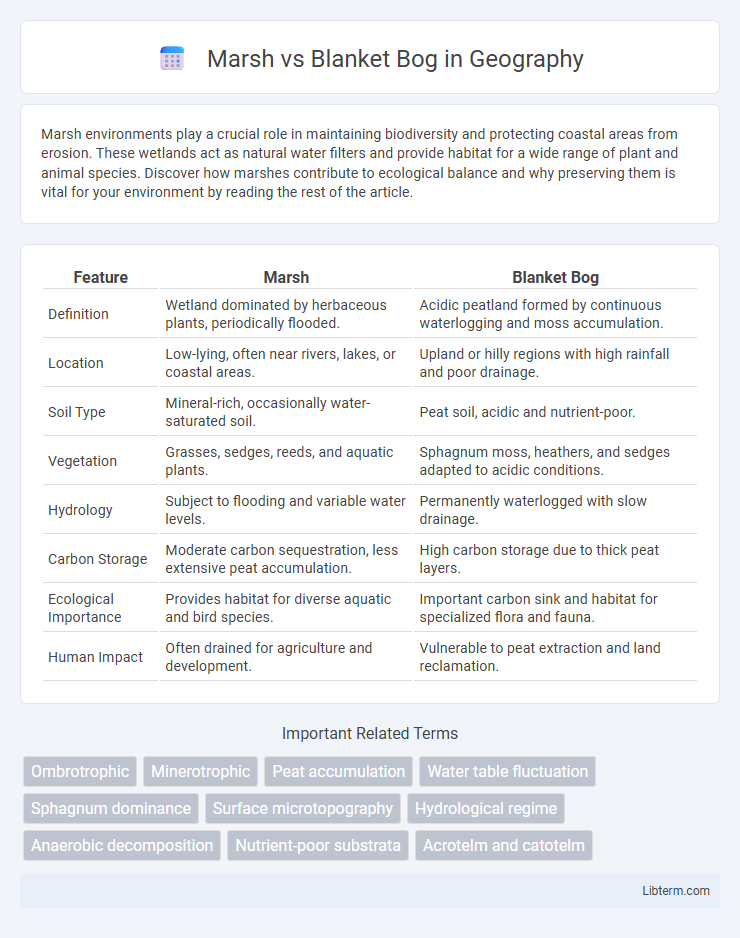Marsh environments play a crucial role in maintaining biodiversity and protecting coastal areas from erosion. These wetlands act as natural water filters and provide habitat for a wide range of plant and animal species. Discover how marshes contribute to ecological balance and why preserving them is vital for your environment by reading the rest of the article.
Table of Comparison
| Feature | Marsh | Blanket Bog |
|---|---|---|
| Definition | Wetland dominated by herbaceous plants, periodically flooded. | Acidic peatland formed by continuous waterlogging and moss accumulation. |
| Location | Low-lying, often near rivers, lakes, or coastal areas. | Upland or hilly regions with high rainfall and poor drainage. |
| Soil Type | Mineral-rich, occasionally water-saturated soil. | Peat soil, acidic and nutrient-poor. |
| Vegetation | Grasses, sedges, reeds, and aquatic plants. | Sphagnum moss, heathers, and sedges adapted to acidic conditions. |
| Hydrology | Subject to flooding and variable water levels. | Permanently waterlogged with slow drainage. |
| Carbon Storage | Moderate carbon sequestration, less extensive peat accumulation. | High carbon storage due to thick peat layers. |
| Ecological Importance | Provides habitat for diverse aquatic and bird species. | Important carbon sink and habitat for specialized flora and fauna. |
| Human Impact | Often drained for agriculture and development. | Vulnerable to peat extraction and land reclamation. |
Introduction to Marshes and Blanket Bogs
Marshes are wetlands characterized by waterlogged soils dominated by herbaceous plants such as grasses, reeds, and sedges, playing a crucial role in biodiversity and water purification. Blanket bogs are peatlands formed in cool, wet climates, where sphagnum mosses accumulate to create thick, acidic peat layers that store carbon and regulate hydrology. Both ecosystems support unique flora and fauna but differ in their hydrological conditions, vegetation types, and peat accumulation processes.
Defining Characteristics of Marshes
Marshes are wetlands characterized by herbaceous plants such as grasses, reeds, and sedges, thriving in nutrient-rich, shallow waters with slow-moving or stagnant conditions. These ecosystems exhibit high biodiversity and act as vital buffers that filter pollutants while providing habitat for numerous bird, amphibian, and insect species. Unlike blanket bogs, marshes typically have neutral to alkaline pH levels and are dominated by mineral soils instead of acidic, peat-accumulating substrates.
Key Features of Blanket Bogs
Blanket bogs develop in cool, wet climates typically found in upland areas, characterized by extensive peat accumulation over large expanses of land. They maintain waterlogged conditions year-round, supporting specialized vegetation such as Sphagnum mosses, heathers, and sedges that contribute to peat formation. Unlike marshes, blanket bogs have acidic, low-nutrient soils that slow decomposition, resulting in significant carbon storage and unique biodiversity.
Formation Processes: Marsh vs Blanket Bog
Marshes form primarily in low-lying areas with slow-moving or stagnant water, where sediment accumulation and plant decay create nutrient-rich, water-saturated soils. Blanket bogs develop in cool, wet climates on acidic, nutrient-poor substrates, where sphagnum moss growth outpaces decomposition, leading to thick peat layers. The contrasting water sources--groundwater and surface runoff for marshes versus direct precipitation for blanket bogs--drive their distinct formation processes and ecological characteristics.
Geographical Distribution Comparison
Marshes predominantly occur in temperate and tropical regions with abundant freshwater, often found along riverbanks, lakes, and coastal wetlands, covering vast areas in North America, Europe, and parts of Asia. Blanket bogs are primarily distributed in cool, humid climates such as those in the British Isles, Ireland, and western Scandinavia, forming extensive peatlands over upland and lowland terrains. While marshes are generally nutrient-rich and support diverse plant species, blanket bogs develop in nutrient-poor conditions, leading to a distinct ecological composition adapted to acidic, waterlogged soils.
Biodiversity in Marshes and Blanket Bogs
Marshes support high biodiversity with a variety of aquatic plants, amphibians, and bird species adapted to nutrient-rich, waterlogged conditions. Blanket bogs host specialized flora such as sphagnum mosses and carnivorous plants, along with unique invertebrates, thriving in acidic, low-nutrient environments that sequester significant carbon. The contrasting ecosystems of marshes and blanket bogs contribute vital habitats for diverse species, playing key roles in maintaining ecological balance and supporting conservation efforts.
Ecological Functions and Services
Marshes, with their saturated soils and abundant emergent vegetation, play a critical role in water purification by filtering pollutants and trapping sediments, thereby enhancing water quality. Blanket bogs, characterized by peat-forming mosses and acidic, nutrient-poor conditions, act as significant carbon sinks, sequestering vast amounts of carbon and mitigating climate change. Both ecosystems provide essential habitats for diverse flora and fauna, support groundwater recharge, and regulate hydrological cycles, contributing to overall landscape resilience and biodiversity maintenance.
Climate Change Impact on Wetland Types
Marshes and blanket bogs respond differently to climate change, with marshes being more prone to fluctuations in water levels and salinity due to increased droughts and flooding. Blanket bogs, which store significant carbon in their peat layers, face heightened risk of carbon release through drying and peat degradation under warmer temperatures. These changes threaten wetland biodiversity and exacerbate greenhouse gas emissions, intensifying climate change feedback loops.
Conservation Challenges and Strategies
Marshes face conservation challenges including habitat loss from agricultural expansion, water pollution, and invasive species that alter native biodiversity. Blanket bogs are threatened by drainage, peat extraction, and climate change, which disrupt hydrology and carbon sequestration. Effective strategies involve protecting hydrological integrity, restoring native vegetation, controlling invasive species, and implementing sustainable land management practices to maintain ecosystem functions.
Conclusion: Marshes vs Blanket Bogs – Key Differences
Marshes are wetlands dominated by herbaceous plants such as grasses and reeds, formed in nutrient-rich, low-lying areas with standing or slow-moving water. Blanket bogs are acidic peatlands covered by sphagnum mosses, developing in cool, wet climates with poor drainage and nutrient-poor conditions. The key differences lie in vegetation type, water chemistry, soil composition, and climatic requirements, influencing their ecological roles and conservation priorities.
Marsh Infographic

 libterm.com
libterm.com